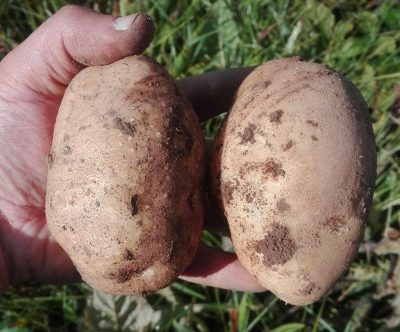
- Authors: Sklyarova Nadezhda Petrovna, Pisarev Boris Anatolyevich, Rudnev Alexander Nikolaevich, Sariev Georgy Mikhailovich, Kukushkin Nikolai Ivanovich, Fomina Nadezhda Mikhailovna, Trofimets Lineon Nikiforovich, Rumyantseva Lidia Petrovna, Kukushkina Lyubov Nikolaevna
- Year of approval: 1993
- Appointment: table, suitable for the production of starch, suitable for the production of French fries, chips, for the production of mashed potatoes
- Tuber weight, g: 90-110
- Peel color: light beige
- Color of the pulp: cream
- Starch content,%: 17-19%
- Tuber shape: rounded oval
- Peel structure: mesh
- Flowers: medium, blue-violet
Potatoes are practically the most popular vegetable, so they are massively grown in vegetable gardens, summer cottages, and farmlands. That is why breeders are engaged in breeding more and more potato varieties, improving old ones, quickly adapting to the climate and soils, giving high yields. One of the most popular is the mid-season potato Blueness of domestic selection.
Breeding history
Blueness is one of the best varieties of Russian selection, created by a group of scientists from the All-Russian Research Institute of Potato Farming named after V.I. A.G. Lorkha in 1988. The culture was bred by crossing the Gatchinsky variety and the 128-6 hybrid. The culture was added to the State Register of approved for use in 1993. The potato variety is zoned in the Central and Northern regions, but in the south the variety is also productive.
Description of the variety
Blueness is a medium-sized shrub with semi-erect branched stems and moderate thickening of dark green shiny leaves. The bush is quite lush and neat. Strong shoots are considered a characteristic feature of the plant. Thanks to the developed rhizome, 10-11 large tubers grow on each bush.
During the flowering period, beautiful flowers of medium size and unusual color appear on the bushes - blue-blue or cornflower blue, which makes the potato bushes decoratively attractive.
Characteristics of the appearance of the bush and root crops
Potatoes Blueness has an attractive presentation. The tubers are endowed with a regular round-oval shape and a rough surface. The color of the vegetable is light beige. The skin of the potato is thin with a mesh cover and sparsely located small eyes. The average weight of a vegetable is 90-110 grams.
The harvested crop tolerates transportation well, and is also able to be stored until March-April under appropriate conditions - cool and lack of high humidity.
Purpose and taste of tubers
Potatoes Blueness have good taste and marketability. The creamy white pulp, which contains 17-19% starch, is characterized by a moderate powdery and creamy texture. The tubers boil well, but do not crumble, without darkening after heat treatment. Boiled potatoes have a pleasant and delicate taste - the potatoes practically melt in your mouth. The advantage of the vegetable is the high content of amino acids in the pulp.
Table potatoes are suitable for making mashed potatoes, chips, boiling in a peel and peeled, for freezing fries.
Maturation
Blueness belongs to the class of mid-season varieties. The ripening period of the vegetable is 90-100 days. The germination capacity of the variety is uncooperative, therefore, the potatoes are dug in several stages.You can start harvesting in early August. To determine how ripe a vegetable is, it is enough to pay attention to the tops - if it wilted or changed color, the potatoes are ready to be dug up.
Yield
This variety is high-yielding. Up to 500 quintals of potatoes can be dug up per hectare of plantations. On average, 2.5-3 kg of tasty potatoes are obtained from one bush.
Growing regions
The variety is massively grown in four regions of Russia - North Caucasian, Central Black Earth, Volgo-Vyatsky and Central.
Growing and caring
Potatoes are planted in late April - early May, when the air temperature is stable at + 7 ... 8 degrees. Late planting can lead to a decrease in the nutritional value of the tubers. For planting, the healthiest medium-sized tubers are selected, which have a sufficient number of emerging shoots 1-2 cm long. Most often, the optimally suitable planting material has a greenish tint after the sprouts appear. The correct scheme for planting is 40x60 or 30x70 cm. It is not recommended to plant this type of potato in an area where nightshades previously grew.
The agricultural technology of vegetable crops consists of standard measures: irrigation (drip system), periodic hilling (not recommended for prolonged drought), loosening and mulching of row spacings with compost and green grass, fertilization (mineral and organic complexes), prevention of fungi and pest attacks.

Planting potatoes is one of the main spring activities traditional for Russian gardeners. There are many ways to plant this vegetable, allowing you to get a good harvest in different conditions and climates. Before planting, you need to carefully prepare the planting material, correctly determine the timing, competently prepare the soil.


Soil requirements
The variety is undemanding to the quality of the soil, the main thing is that it is fertile, breathable, loose, without swampiness and stagnant moisture. Loamy and sandy loamy nutrient soils are considered ideal for productive growth.

Required climatic conditions
Blue loves the sun, warmth, space, and also tolerates minor temperature fluctuations and short drought.
Disease and pest resistance
Table potatoes are highly immune. It is endowed with high and medium resistance to a number of diseases and viruses - alternaria, potato cancer, rhizoctonia, late blight of tubers and leaves, common scab. Most often, potato bushes are exposed to the golden nematode. It is characteristic that the Blueness potato is completely unattractive to the Colorado potato beetle.

Potatoes are a popular vegetable crop that many gardeners planted on their site.But growing a bountiful harvest of tasty and large tubers is unlikely to succeed if the beds are not properly protected from the most common diseases and pests. Often, the development of diseases of various etiologies of potatoes goes unnoticed, so it is important to identify the problem in time and eliminate it.
















































































